Bulletin – June 2012 Australia's Productivity Performance and Real Incomes
- Download the article 744KB
Abstract
In the medium to long run, the growth of real income depends largely on productivity growth. Australia's trend productivity growth declined noticeably in the 2000s compared with the period of strong growth in the 1990s. However, the effect of the decline in productivity growth on per capita real income growth has been offset by the boost to incomes from the rise in the terms of trade over the past decade. Much of the moderation in the pace of productivity improvement can be attributed to a decline in the level of productivity in the mining and utilities industries. Nevertheless, there has also been a broad-based slowdown across other industries, with productivity growth declining in almost all industries. The fall in mining productivity is largely a consequence of strong global demand, and the effect on income has been offset by high prices for resources, which has justified increasingly costly extraction. In contrast, the weakness in productivity growth outside of the mining industry has imposed a cost on the domestic economy, in part through higher non-tradables prices than would otherwise have been the case. With the terms of trade likely to moderate over the next few years, real income growth will slow unless there is a pick-up in productivity growth. For inflation to remain consistent with the Bank's target this will also imply a slowing in the pace of growth in nominal factor incomes.
Introduction
Productivity refers to the efficiency with which an economy employs resources to produce economic output. Growth in productivity is the key driver of growth in per capita income and living standards in the long run. The trend in productivity growth is determined by the development of new technologies and how efficiently resources – labour, capital and fixed resources (such as land) – are organised in the production process. These are factors that determine the capacity of the economy to supply goods and services and are not directly responsive to monetary policy in the short run. Nevertheless, because inflationary pressures reflect the balance of supply and demand growth in the economy, trend productivity growth is an important determinant of the pace at which the economy can grow over the medium term without generating inflationary pressures. Understanding developments in trend productivity growth is therefore an important consideration for monetary policy formulation.
Following a period in the 1990s and early 2000s when, by historical standards, Australia experienced unusually rapid productivity growth, trend productivity growth slowed over the latter part of the 2000s. The slowing in aggregate productivity growth is widely recognised, but there has been some debate about how broad based this has been across industries and about the reasons for the slowdown. Weaker productivity outcomes have been especially pronounced in the mining and utilities industries, where the level of productivity has fallen. However, there has also been a marked slowing in trend productivity growth across most other industries.
The historically high trend productivity growth in the 1990s allowed the economy and incomes to grow at a relatively rapid pace without generating inflationary pressures. This experience was common to a wide range of countries in the 1990s, and over time it became evident that unexpectedly strong trend growth in productivity was contributing to low inflation outcomes compared with earlier decades. More recently, the rise in Australia's terms of trade has allowed real incomes to grow faster than productivity without generating inflationary pressures.
This article reviews the evidence on Australia's productivity performance and discusses the implications for income growth and inflation. The article first provides some data on the decomposition of trend labour productivity into the contributions from capital deepening and multifactor productivity over recent decades. (Labour productivity measures the amount of output produced per unit of labour input – measured in hours worked – while multifactor productivity measures the amount of output for a given amount of both labour and capital inputs). Despite continued capital deepening for the economy overall, there has been broad-based slowing in labour productivity owing to a slowdown in multifactor productivity growth. The second part of the article reviews some of the proposed explanations for the slowdown in trend productivity growth in the 2000s compared with the rapid growth of the 1990s. The final section discusses how, despite the offsetting effect of the rise in the terms of trade on real incomes growth, slower productivity growth outside of the mining industry has been a drag on real income growth and, at the margin, contributed to inflationary pressure in the economy.
Australia's Productivity Performance in the 2000s
One of the difficulties when analysing developments in productivity growth is separating short-term cyclical effects from changes in underlying trend productivity growth. From the perspective of understanding the implications for monetary policy, it is changes to the trend rate of productivity growth that are most relevant. In this article we abstract from short-term volatility by looking at average growth rates over the productivity growth cycles identified by the Australian Bureau of Statistics (ABS), but we also include recent data covering part of an incomplete productivity growth cycle. Although using an incomplete cycle risks including some cyclical element in the estimates of trend growth, the forward looking nature of monetary policy means that it is necessary to attempt to update estimates of the trend in real time. Throughout the article, the 1990s is used to refer to the period covering the two ABS growth cycles between 1993/94 and 2003/04, and the 2000s refers to the period between 2003/04 and 2010/11.[1]
As has been recognised by a range of analysts and commentators,[2] Australia's productivity growth slowed in the 2000s compared with the very strong productivity growth of the 1990s (Graph 1). The slowdown is evident for the whole economy, but it is most appropriate to focus on the market sector, which accounts for around two-thirds of total output. Inputs and outputs in the market sector can be independently measured so that productivity outcomes can be calculated directly. But, for the non-market sector, including large parts of the health and education industries, there are no market transactions for output, making it difficult to measure output – and therefore productivity – independently of inputs.
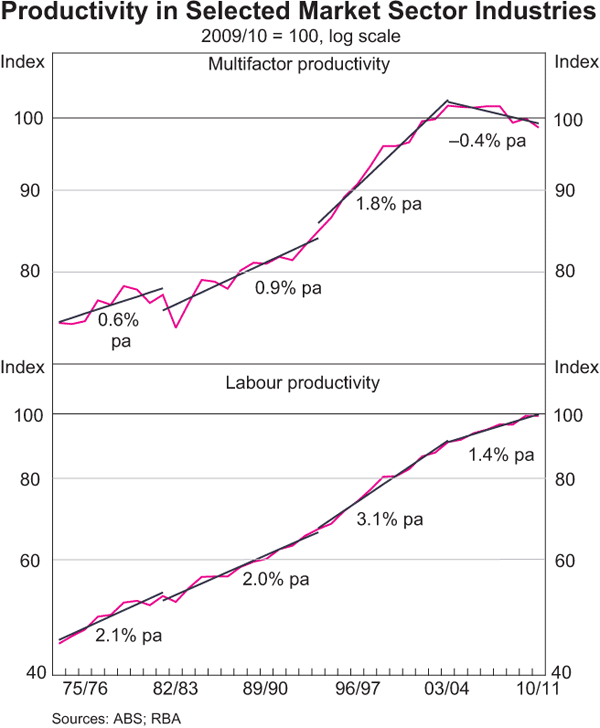
Growth in labour productivity is typically higher than multifactor productivity because it includes the additional labour productivity generated by capital deepening as the capital-labour ratio grows over time. Decomposing labour productivity growth into capital deepening and multifactor productivity growth indicates that the slowdown in labour productivity growth has been a result of slower growth in multifactor productivity (Table 1). Indeed, the contribution of capital deepening to labour productivity growth was somewhat larger in the 2000s than in the 1990s. This is because investment and capital accumulation were quite strong in the 2000s, largely reflecting the increase in the share of resources used by the rapidly expanding and capital-intensive mining and utilities industries. However, somewhat surprisingly, despite the high level of investment in these two industries, capital deepening within these industries stalled during this period because there was also a very large increase in labour inputs (Table 2). Outside of these industries, the pace of capital deepening was around the same as in the earlier period, with the slowdown in labour productivity growth entirely due to the slowing in multifactor productivity growth.
| 1973/74 to 1993/94 |
1993/94 to 2003/04 |
2003/04 to 2010/11 |
|
|---|---|---|---|
| Selected market-sector industries(a) | |||
| Labour productivity | 1.8 | 3.1 | 1.4 |
| of which:(b) | |||
| Capital deepening | 1.3 | 1.3 | 1.8 |
| Multifactor productivity | 0.6 | 1.8 | −0.4 |
| Excluding mining and utilities | |||
| Labour productivity | – | 3.1 | 1.7 |
| of which:(b) | |||
| Capital deepening | – | 1.3 | 1.3 |
| Multifactor productivity | – | 1.9 | 0.4 |
|
(a) Market sector excluding rental, hiring & real estate services,
professional, scientific & technical services, administrative Sources: ABS; RBA |
|||
| 1993/94 to 2003/04 |
2003/04 to 2010/11 |
|
|---|---|---|
| Mining | ||
| Labour productivity | 3.6 | −6.3 |
| of which:(a) | ||
| Capital deepening | 2.9 | −0.6 |
| Multifactor productivity | 0.6 | −5.7 |
| Utilities | ||
| Labour productivity | 1.8 | −5.5 |
| of which:(b) | ||
| Capital deepening | 2.0 | −0.8 |
| Multifactor productivity | −0.2 | −4.7 |
|
(a) Contributions to labour productivity growth may not sum to totals due to rounding Sources: ABS; RBA |
||
The deterioration in multifactor productivity growth has been most pronounced in the mining and utilities industries, with both industries experiencing a large fall in the level of multifactor productivity (Graph 2). Although the decline in the level of multifactor productivity is unusual, the reasons behind the fall are now well understood.
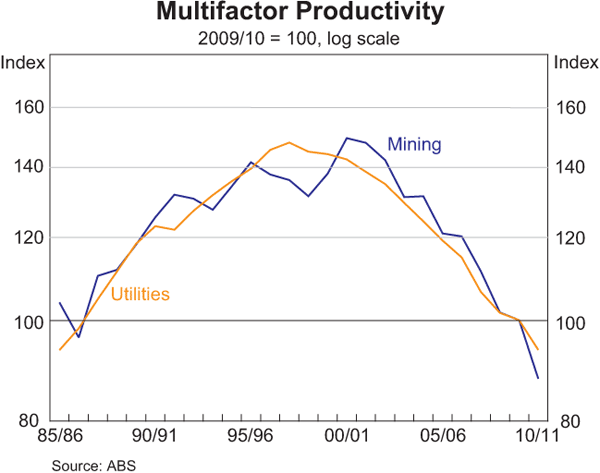
In the case of the mining industry, the fall in productivity is partly a natural consequence of the rapid run-up in commodity prices, which has increased the profitability of more marginal deposits.[3] Higher commodity prices justify more difficult and costly extraction of previously undeveloped resources, which becomes necessary over time as developed deposits are depleted. The very rapid pick-up in commodity prices has also justified an unprecedented increase in capital investment in the industry. This growth in measured capital inputs has detracted from measured productivity owing to the lag (of some years) between the initial investments, the completion of projects and the utilisation of all the new capacity. In effect, the productivity developments in the mining industry are best characterised as a movement up the industry's supply curve, rather than an exogenous shift in the supply curve related to some fundamental change in underlying productivity.
The fall in the level of productivity in the utilities industry is also related to large investments, which have been necessary to deal with some of the fundamental structural challenges facing the industry, but these investments have not necessarily resulted in higher quantities of measured output. Part of the surge in investment over recent years reflects a significant catch-up that has required rapid growth in utilities' workforces after a period in the 1990s when investment and employment in the industry were falling.
There has also been additional investment to improve the reliability of supply in the electricity and water industries, which has only made a marginal contribution in terms of additional measured output. One example is recent investment in desalination plants that, with the return to high rainfall in recent years, are not currently being utilised fully, but will provide a source of fresh water in the event of future droughts. Similarly, some of the additional investment in the electricity sector has been associated with the need to meet an increase in peak demand relative to base-load demand.[4] In addition, environmental considerations have required new investments in waste treatment and low carbon emission electricity generation; while these investments provide environmental benefits, they also decrease measured productivity and increase the unit costs of production. In other words, some of the decline in productivity in the utilities sector can be attributed to measurement issues; the environmental benefits and more reliable supply are not measured as part of the industry's output, but considerable resources are allocated to producing them.
The large declines in productivity in the mining and utilities industries account for a significant part of the slowdown in aggregate market sector productivity growth between the 1990s and the latter part of the 2000s. However, almost all remaining industries have also experienced a slowing in productivity growth. One way to assess the significance of the general slowdown in productivity is to calculate productivity growth rates for the market sector excluding the mining and utilities industries. Although not as pronounced as the decline in productivity growth for the market sector as a whole, the slowdown in productivity growth excluding mining and utilities is nevertheless notable, with average labour and multifactor productivity growth around 1½ percentage points lower than in the 1990s.
While much of the surge in investment in recent years has been concentrated in the mining and utilities industries, investment outside of these industries was also strong over most of the 2000s. Even though capital deepening has made a similar contribution to labour productivity growth as in the 1990s, growth in labour productivity has been dragged down by weaker multifactor productivity growth. This suggests that the general slowdown in productivity growth cannot be attributed to weak investment, but is likely to be associated with either a slowdown in the pace of adoption of productivity-enhancing technological innovations or less rapid improvement in the efficiency with which capital and labour are employed. Moreover, the broad-based slowing in multifactor productivity growth within most industries suggests that much of the slowing is likely to be associated with general developments affecting all industries (Graph 3). Consistent with this, Parham (2012) finds that only a little of the slowdown in productivity growth can be attributed to shifts in the shares of activity between high and low productivity industries.
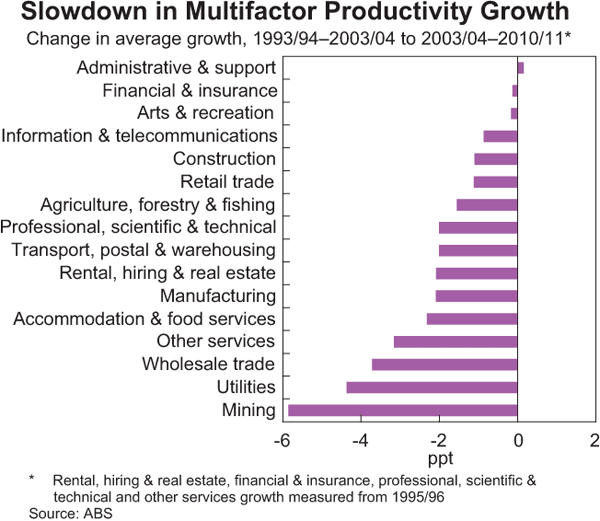
Multifactor productivity outcomes in the 2000s were clearly weaker than the period of strong growth in the 1990s. However, the difference between trend growth in the 2000s and the long-run average prior to the 1990s is less marked. For the market sector excluding mining and utilities, the average growth in multifactor productivity of 0.4 per cent in the 2000s is only 0.2 percentage points lower than the average for the market sector in the period 1973/74 to 1993/94. This suggests that it is the 1990s that was the period of exceptional growth.
Explanations for the General Slowdown in Productivity Growth
The above analysis suggests that there has been a broad-based slowdown in multifactor productivity growth that cannot be fully explained by the special circumstances affecting the mining and utilities industries. However, while the measured slowdown in productivity growth is significant, it is not large enough that the causes can be easily identified statistically. Two issues make it difficult to be definitive about the underlying drivers of changes in productivity: there is considerable measurement error in the estimates of productivity growth making it difficult to be precise about the timing of changes in the underlying trend; and productivity growth is the result of the interaction of many fundamental and proximate factors. Technological, structural and regulatory changes, as well as cyclical variation in factor utilisation, can all affect measured productivity, making it very difficult to identify and disentangle the various effects.[5] Parham (2012) provides a recent review of the importance of volatility and cyclical effects, compositional shifts, adjustment pressures and measurement errors for the decline in measured trend productivity growth over the 2000s.[6] At a fundamental level, productivity is determined by the available technology (including the knowledge of production processes held by firms and individuals) and the way production is organised within firms and industries. Conceptually, economists often view technology as determining the productivity ‘frontier’ that is, the maximum amount that could be produced with given inputs. Factors affecting how production is organised, including policies affecting how efficiently labour, capital and fixed resources are allocated and employed within the economy, determine how close the economy is to the frontier. Trend productivity growth is then determined by the rate at which new technologies become available – how fast the frontier is expanding – and the rate of improvement in efficiency – how fast the economy is approaching the frontier.
Overall, there is some evidence that both a slowdown in the pace at which the frontier is expanding and the pace at which Australia is approaching the frontier have contributed to the decline in the rate of productivity growth relative to the historically high growth of the 1990s. However, there is little evidence that a lack of incentives to invest in physical capital has been significant in explaining the slowdown in multifactor productivity growth.
Technology, innovation and education
An important driver of growth in the production frontier in the long run is improvements in technology. Technological improvements may be acquired from overseas or developed domestically through innovation. In both cases, firms will typically need to undertake investment to purchase new capital goods and knowledge, or undertake research and development in order to achieve productivity improvements. Only in the case where new knowledge becomes freely available will firms experience a technology driven improvement in productivity without undertaking new investment. However, not all investment will necessarily lead to an improvement in measured multifactor productivity.
As already discussed, the slowdown in multifactor productivity growth has occurred despite continued strong growth in investment. In many cases, new investment involves increasing the capital stock based on existing technologies, and although this capital deepening may improve labour productivity, it does not necessarily improve multifactor productivity. Even in cases where firms are investing in new capital goods that ‘embody’ technological refinements to existing technologies, such as improved computing power, these quality improvements may be accounted for by the ABS as capital deepening and not necessarily an improvement in multifactor productivity. For investment to drive gains in multifactor productivity there needs to be ‘spillover’ effects that generate a more than commensurate increase in output than the increase in capital.[7] In practice, this typically requires the introduction of a new technology to be associated with some fundamental reorganisation of production processes, or the development of a genuinely new technology that has benefits greater than the research costs required to develop it. For these reasons, economists generally view the likely drivers of multifactor productivity as being research and development expenditure, investment in human capital, and investments in capital equipment that can fundamentally change the way firms operate, such as information and communication technologies (ICT).
That productivity growth has slowed across a large number of developed economies in the 2000s provides some indication that there may have been a slowing in the pace at which the technological frontier is expanding. Data on productivity growth for members of the Organisation for Economic Co-operation and Development (OECD) indicate a fairly universal slowing in productivity growth in the 2000s compared with the 1990s, with 19 of 25 countries experiencing a slowdown in productivity growth (Graph 4).[8] It is difficult to be conclusive about what might have driven this common international experience, but it suggests that part of the slowdown may be related to common global factors, such as the pace of technological innovation and adoption. However, the apparent slower expansion of the technological frontier does not seem sufficient to explain all of the slowing in Australia's productivity performance. An indication of this is that the slowdown in Australia's productivity growth in the past decade has been greater than the average slowdown in OECD countries. Moreover, it is less apparent that the United States, which is typically recognised as representing the global productivity frontier, has seen a slowdown in productivity growth over the decade.[9]
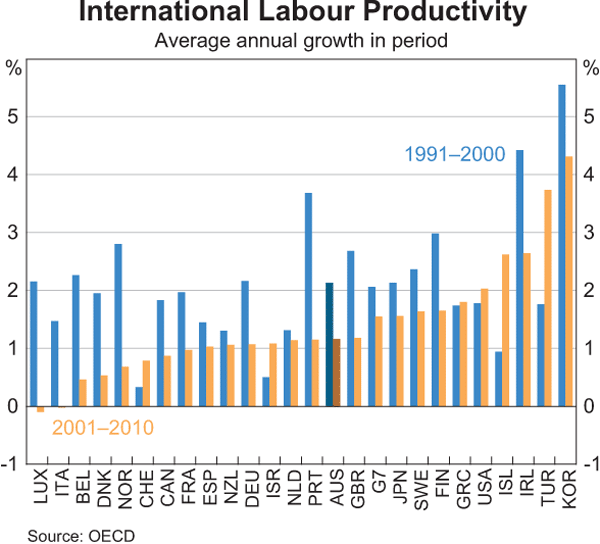
One possible explanation for the surge and subsequent decline in multifactor productivity growth in Australia, and perhaps in other developed economies, over the past two decades is the pattern of adoption of ICT, which are primarily developed and produced offshore.[10] The widespread adoption of these technologies through the 1990s was largely complete by the early 2000s. Assuming that the introduction of computers created a gradual upward shift in the level of productivity of some workers (in addition to the contribution from capital deepening) this would have been reflected in strong multifactor productivity growth in the 1990s, with the contribution to productivity growth moderating in the 2000s once rates of usage had stabilised.[11] Anecdotally, it does not seem that the global pace of technological development in computing (most obviously in mobile devices) has slowed over the past decade; indeed the number of global patent grants increased over the decade (WIPO 2011). However, it is possible that more recent innovations have not led to significant reorganisation of production – and therefore improvements in multifactor productivity – as was the case with the initial introduction of computers and increased use of the internet.
While the expansion of the technological frontier is largely determined by the global rate of innovation, domestic innovation and investment in human capital can also help push out the domestic frontier. Domestic innovation is largely driven by firms' research and development (R&D) activities. However, ABS (2010) data show that there has been an increase in expenditure on R&D as a share of GDP in the 2000s, suggesting that the rate of domestic expenditure on innovation has not been a major drag on productivity growth.
One indicator of the contribution to output growth from increasing human capital, and in particular education and experience, is the ABS measure of ‘quality-adjusted hours worked’. This measure has been growing at a consistently faster pace than the standard measure of hours worked since the 1980s, indicating that education and experience are likely to have made positive contributions to multifactor productivity growth over this period (Graph 5).However, the pace of growth of this measure of labour input has slowed, suggesting that a smaller contribution from improving labour quality has played some role in the productivity slowdown.
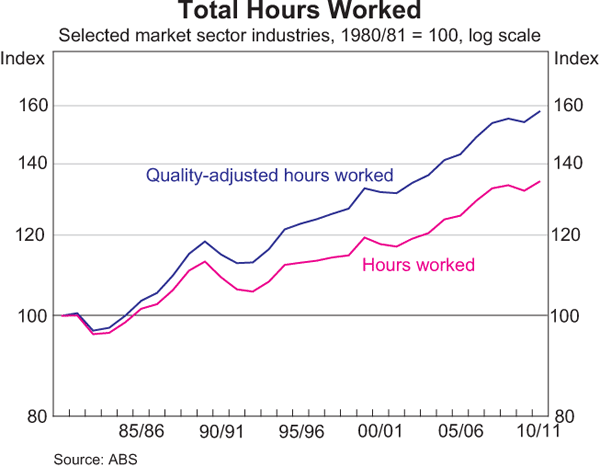
Regulatory reform and economic efficiency
The most widely accepted explanation for the acceleration and subsequent slowing in productivity growth over the past two decades relates to the gradual waning of the impetus to productivity growth initiated by the economic policy reforms of the 1980s and 1990s (Dolman 2009; Eslake 2011). These reforms, which included tariff reductions, privatisation, liberalisation of financial markets, decentralisation of the labour market and, somewhat later, national competition policies and tax reform, are widely viewed as having contributed to a marked improvement in economic efficiency.[12] The overall effect of all these reforms was to increase competitive pressures on firms in product markets such that improvements in productivity became an imperative for economic survival, while at the same time increased flexibility in capital and labour markets ensured that economic resources were allocated more efficiently among competing firms. It is difficult to be definitive about the magnitude of the impact of regulatory reforms, as in many cases, for example with tariff cuts, the changes were introduced gradually over an extended period of time, with the impact on productivity occurring only with a lag.[13]
While some analysts have argued that these reforms should have permanently lifted the growth rate of productivityrelative to the unobserved counterfactual, the experience of the past two decades suggests that the effect on productivity growth may have been temporary. Productivity growth appears to have been higher during a ‘catch-up’ period when reorganisation in response to the reforms drove improvements in economic efficiency allowing the economy to move closer to the production frontier, but over time the effect of these reforms on the pace of productivity growth appears to have waned. In addition, some commentators, for example Eslake (2011), have argued that there has not only been a lack of further productivity-enhancing regulatory reforms over the past decade, but that the introduction of new inefficient regulations may have created a drag on productivity growth.[14]
Incentives and economic prosperity
A complementary explanation of the slowdown in productivity growth in Australia is that over the course of the long economic expansion between the early 1990s domestic recession and 2008 global recession, the incentives for firms, workers and governments to implement productivity-enhancing changes gradually weakened. In effect, broad-based economic prosperity has likely eased the pressures driving productivity improvements. Most productivity-enhancing changes involve a degree of reorganisation that can be difficult for firms and workers, and without clear incentives for change there is unlikely to be a strong focus on enhancing productivity. A related explanation for the pattern of productivity growth over the past two decades offered by Quiggin (2011) is that the strength of productivity growth in the 1990s was entirely due to greater intensity of work during this period, meaning that productivity was in effect overestimated owing to mismeasurement of labour inputs.[15]
As discussed further below, the boom in the terms of trade over the past decade has allowed national income to grow at a faster pace than productivity. This historically unusual development supported profit, tax and wage growth, and, up until the global financial crisis, strong growth in asset prices and wealth. The persistent decline in the unemployment rate over this period also contributed to a strong sense of economic prosperity compared with earlier decades, at least up until the global recession in 2008. This is the flip side of Schumpeter's (1954) thesis that material improvements in productivity are driven by a process of ‘creative destruction’, whereby economic activity is reorganised during periods of economic stress when more intense competitive pressure drives productivity improvements.
Productivity, Terms of Trade and Income Growth
In the long run, growth in productivity is the primary determinant of growth in real income, but sustained changes in the terms of trade mean that real income growth per hour worked can diverge from productivity growth for a period of time. Over the 1990s, strong growth in productivity was the primary source of increases in real incomes. In contrast, the boom in the terms of trade over the past decade has allowed national income to grow at a faster pace than productivity (output per hour worked; Graph 6). Indeed, income per hour worked has grown over the past decade at similar pace to the proceeding period despite the slowdown in productivity.
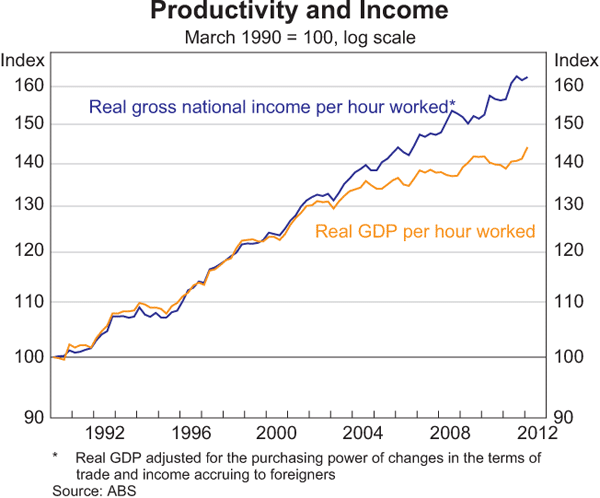
To understand how this has occurred, it is useful to distinguish between the drivers of the productivity developments across industries and the implications of these for domestic incomes. On the one hand, the decline in productivity in the mining industry is largely an endogenous response to higher global demand. The increase in demand has pushed the industry up the supply curve, increasing prices and export volumes. The effect of the increase in prices on export income has more than offset the fall in the industry's productivity. In other words, Australia's trade and investment partners have been willing to incur the increasingly high costs, in terms of labour and capital, required to extract resources. Lower productivity and higher mining costs have also been experienced by other resource-exporting countries as they also attempt to respond to the rapid increase in global demand, and so Australia has not been competitively disadvantaged by these developments.
In contrast, the economic cost of the slowing in productivity growth outside of the mining industry has been largely borne by the domestic economy. For the non-traded sectors of the economy, lower productivity must in one way or another be reflected in some combination of lower income for domestic producers and/or higher costs for domestic consumers. In trade-exposed parts of the economy outside of mining, a slowdown in productivity reduces competiveness against foreign producers, and so is also likely to result in a loss of real income for domestic producers, who are unable to pass on higher costs to domestic consumers owing to competition from imports.
There is some evidence that the general slowdown in productivity growth outside the mining industry has resulted in higher increases in real consumer prices for non-tradables than would otherwise have been the case. In this way, the general slowdown in productivity has weighed on real income for the economy overall. At the same time, the high Australian dollar, which has appreciated in response to the strength in commodity prices, has helped to hold down real tradables prices: this is an important mechanism through which the benefits of the mining boom are spread to all consumers (Stevens 2011).
The domestic burden of lower productivity growth is most evident for the utilities sector, where the fall in the level of multifactor productivity has resulted in higher unit costs and ultimately higher real consumer prices (Graph 7).[16] Although the slowdown in productivity growth in the remainder of the non-traded sector has been less pronounced than for utilities, there is evidence that the broad-based slowdown has contributed to somewhat stronger non-tradables inflation over the past decade compared with the 1990s.[17] Non-tradables consumer price inflation averaged around 4 per cent in the period 2004/05 to 2010/11, while overall inflation averaged 3 per cent (Graph 8). This compares with non-tradables inflation of around 3 per cent on average between 1994/95 and 2004/05, and overall inflation of 2½ per cent. It is difficult to be precise about the contribution resulting from slower productivity growth, partly because the inflation data cover non-market parts of the economy for which productivity is not well measured. Nevertheless, the magnitude of the pick-up in inflation is broadly consistent with the additional growth in unit labour costs associated with the slowdown in multifactor productivity growth of around 1½ percentage points over this period.
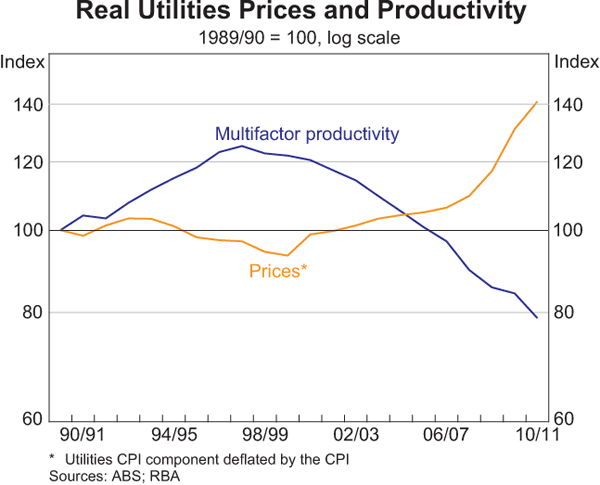
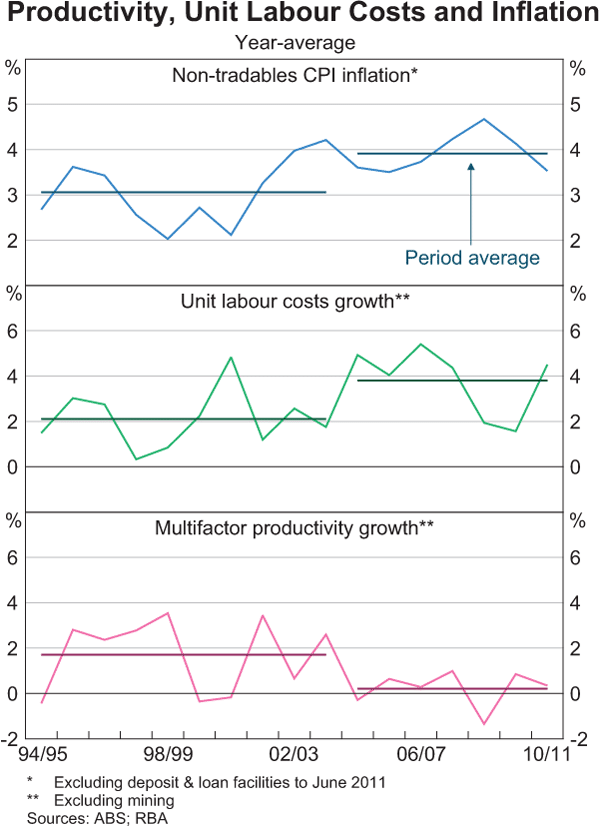
It is not unusual in developed economies for non-tradables inflation to be higher than overall inflation, in part because productivity growth in domestic non-traded industries is typically lower than it is in global traded goods industries. It is also necessary for relative prices to adjust in response to fundamental differences in productivity developments across industries. However, within an inflation-targeting regime, it is important that the upward pressure on prices generated by a general slowdown in productivity growth does not spill over to higher overall inflation.
In general, inflationary pressures will reflect the balance of supply and demand in the economy, and so the role of productivity growth in determining the supply potential of the economy is a key limitation on the pace at which the economy, and consequently real and nominal incomes, can grow without generating inflationary pressures. To keep inflation low and stable, monetary policy needs to be attuned to persistent changes in productivity growth to ensure that growth in demand and nominal factor incomes remain consistent with the economy's supply potential, and hence with the inflation target. While a pick-up in productivity growth may allow wages and profits to accelerate without jeopardising low inflation, a slowing in productivity growth usually requires a slowing in demand and nominal income growth in order for inflation to remain low.[18]
The experience of many developed countries in the 1970s, including Australia, showed how a failure to recognise the implications for real income growth of a slowing in trend productivity ultimately contributed to high inflation.[19] Conversely in the 1990s, unexpectedly strong productivity outcomes allowed monetary policy to accommodate strong growth in factor incomes while inflation remained relatively low. Over recent years, the effect of slower productivity growth on real incomes was offset by the rapid rise in the terms of trade, allowing real incomes to grow faster than trend productivity. However, over the next few years, the terms of trade are likely to decline gradually and so, on average, real incomes can be expected to grow by less than productivity. Unless there is a pick-up in productivity growth, this will imply slower growth in real incomes than in the past few decades. A slowdown in real income growth will also imply more moderate growth in nominal factor incomes if growth is to remain consistent with the Bank's inflation target.
Summary and Outlook
Following a period of rapid growth in the 1990s, the trend rate of multifactor productivity growth in the Australian economy declined in the latter part of the 2000s. The slowdown in productivity growth has been broad based across industries, with the level of productivity actually falling in the mining and utilities industries. However, this did not result in a decline in the growth rate of real incomes, with the slowdown largely compensated for by the rise in the terms of trade, which allowed real incomes to grow faster than productivity. Average inflation has only been slightly higher than in the period of strong productivity growth in the 1990s, with slower productivity growth and strong growth in nominal incomes evident in higher non-tradables inflation, while tradables inflation has remained relatively subdued.
Most analysts expect the terms of trade to decline gradually from the current high level over the next few years. In contrast to developments over the past decade, this implies that real incomes will grow slower than productivity. Consequently, unless there is a pick-up in trend productivity growth, the pace of growth of nominal factor incomes will need to slow for inflation to remain consistent with the Bank's inflation target.
Although it is not possible to gauge the extent of changes in trend productivity growth from a few quarters of data, there are signs that productivity growth has picked up over the past year. As emphasised in a number of recent Bank publications, structural change relating to a range of factors, including the high exchange rate, is increasing the competitive pressures faced by a broad range of firms across the non-mining economy (Lowe 2012). In time, the response of firms and workers to these competitive pressures is likely to contribute to some improvement in trend productivity growth. A recovery in productivity growth, if it occurs, will ease some of the upward pressure on unit costs and inflation, and allow for stronger growth in real incomes.
Footnotes
The authors are from Economic Analysis Department.
[*]
The purpose of identifying cycles is to allow underlying trends in productivity to be estimated, by identifying a period during which short-term cyclical effects largely cancel out. Including the incomplete cycle of 2007/08 to 2010/11 in the analysis does not change the conclusions presented in this article, but it does strengthen them somewhat. [1]
Dolman (2009) and Eslake (2011) provide comprehensive reviews of the productivity slowdown, as does Parham (2012), although he concentrates on comparing the late 2000s with the early 2000s. See Richardson and Denniss (2011) for a somewhat different assessment. [2]
Topp et al (2008) provide a comprehensive review of the causes of the fall in mining multifactor productivity. [3]
For a discussion of this and other developments in the utilities sector, see Topp and Kulys (2012). [4]
We do not focus on cyclical aspects of productivity in this article. As discussed in footnote 1, the ABS productivity growth cycles, on which our analysis of trend productivity growth is based, are designed to abstract from the cyclical effects of capacity and labour utilisation on measured productivity. However, cyclical changes in the unemployment rate and survey measures of capacity utilisation do not line up perfectly with the ABS productivity cycles. It is possible that some of the slowing in measured productivity reflects the lower level of the unemployment rate and higher level of capacity utilisation in the 2000s compared with 1990s. Our estimates suggest that the drag on productivity growth from the general absorption of spare capacity over the past two decades has been relatively small, accounting for, at most, one-fifth of the slowdown in multifactor productivity growth. [5]
Parham suggests that for the selected market sector industries, these four factors account for between half and three-quarters of the slowdown over the last two complete productivity growth cycles. As discussed above, for the mining and utilities industries, these factors are likely to have accounted for a larger share of the decline in productivity between the 1990s and 2000s. [6]
In the productivity literature these spillover effects on multifactor productivity are referred to as ‘disembodied’ technical change. [7]
Dolman, Lu and Rahman (2006) found that the slowdown in productivity growth at that time appeared to be unique to Australia. However, with additional data it has since become apparent that many OECD economies experienced a slowdown in productivity growth in the 2000s. [8]
However, see Kahn and Rich (2011) who argue that recent GDP data vintages do suggest that the United States also entered a period of lower trend productivity growth around 2004, following strong productivity growth in the early 2000s. [9]
One ICT technology which has likely had spillover effects and was partly developed in Australia by the CSIRO is Wi-Fi. [10]
Note that the measurable contribution to labour productivity growth from ICT capital deepening has slowed only modestly (Dolman 2009). [11]
See Productivity Commission (1999) for a detailed discussion of the effects of microeconomic reforms in the 1980s and 1990s. [12]
Quiggin (2011) disagrees with the consensus view and argues that the timing of the reforms was too distant from the pick-up in productivity growth in the early 1990s for policy reforms to have been a major driver of the improvement in productivity. However, Kent and Simon (2007) provide cross-country evidence that regulatory reforms can have a positive effect on productivity over the subsequent 5 to 10 years. [13]
Although regulations may reduce measured productivity, the impact of a specific regulation must be assessed on both the costs and benefits resulting from its introduction. Regulations are typically introduced to remove, or reduce, some perceived negative externality, and the benefit of doing so may offset the costs resulting from decreased productivity. [14]
Quiggin (2011) points to data on the share of workers working more than 50 hours per week as a proxy measure of high work intensity in the 1990s versus the 2000s. However, there is no comprehensive data on work intensity across all workers with which to test the significance of this specific effect relative to other explanations. [15]
It is not surprising that there is a relatively tight link between productivity, unit costs, and consumer prices for utilities as the pricing of utilities is largely regulated on the basis of ‘cost plus’ formulas. Plumb and Davis (2010) discuss the cost increases underpinning developments in utilities prices in detail. [16]
For a recent discussion of this point, see Lowe (2011). [17]
Trichet (2007) and Yellen (2005) discuss how a change in trend productivity growth may affect the demand and supply balance in the economy. The implications for inflation and monetary policy depend on whether the change in trend productivity is anticipated, or even recognised in real time, by private agents in the economy and by the central bank. [18]
Cagliarini, Kent and Stevens (2010) discuss the implications of supply-side developments for inflation in the 1970s. [19]
References
ABS (Australian Bureau of Statistics) (2010), ‘Research and Experimental Development, All Sector Summary, Australia 2008–09’, ABS Cat No 8112.0, October.
Cagliarini A, C Kent and G Stevens (2010), ‘Fifty Years of Monetary Policy: What Have We Learned?’, in R Fry, C Jones and C Kent (eds), Reserve Bank of Australia 50th Anniversary Symposium, Proceedings of a Conference, Reserve Bank of Australia, Sydney, pp 9–37.
Dolman B (2009), ‘What Happened to Australia's Productivity Surge?’, Australian Economic Review, 42(3), pp 243–263.
Dolman B, L Lu and J Rahman (2006), ‘Understanding Productivity Trends’, Economic Roundup, Summer, pp 35–52.
Eslake S (2011), ‘Productivity: The Lost Decade’, in H Gerard and J Kearns (eds), The Australian Economy in the 2000s, Proceedings of a Conference, Reserve Bank of Australia, Sydney, pp 223–254.
Kahn J and R Rich (2011), ‘The Productivity Slowdown Reaffirmed’, Federal Reserve Bank of New York Liberty Street Economics blog. Available at <http://libertystreeteconomics.newyorkfed.org/2011/09/the-productivity-slowdown-reaffirmed.html>.
Kent C and J Simon (2007), ‘Productivity Growth: The Effect of Market Regulations’, RBA Research Discussion Paper No 2007-04.
Lowe P (2011), ‘Inflation: The Recent Past and the Future’, Keynote Address to the BankSA ‘Trends’ Business Luncheon, Adelaide, 24 June. Available at <http://www.rba.gov.au/speeches/2011/sp-ag-240611.html>.
Lowe P (2012), ‘The Changing Structure of the Australian Economy and Monetary Policy’, RBA Bulletin, March, pp 79–84.
Parham D (2012), ‘Australia's Productivity Growth Slump: Signs of Crisis, Adjustment or Both?’, Productivity Commission Visiting Researcher Paper, April.
Plumb M and K Davis (2010), ‘Developments in Utilities Prices’, RBABulletin, December, pp 9–17.
Productivity Commission (1999), ‘Microeconomic Reform and Australian Productivity: Exploring the Links’, Research Paper, November.
Quiggin J (2011), ‘Wrap-up Discussion: The Lost Golden Age of Productivity Growth’, in H Gerard and J Kearns (eds), The Australian Economy in the 2000s, Proceedings of a Conference, Reserve Bank of Australia, Sydney, pp 367–377.
Richardson D and R Denniss (2011), ‘Mining Australia's Productivity: The Role of the Mining Industry in Driving Down Australia's Productivity Growth’, The Australia Institute Policy Brief No 31.
Schumpeter J (1954), History of Economic Analysis, Oxford University Press, New York.
Stevens G (2011), ‘Economic Conditions and Prospects’, RBA Bulletin, September, pp 83–88.
Topp V and T Kulys (2012), ‘Productivity in Electricity, Gas and Water: Measurement and Interpretation’, Productivity Commission Staff Working Paper, April.
Topp V, L Soames, D Parham and H Bloch (2008), ‘Productivity in the Mining Industry: Measurement and Interpretation’, Productivity Commission Staff Working Paper, December.
Trichet J-C (2007), ‘Productivity in the Euro Area and Monetary Policy’, Address to the 22nd Annual Congress of the European Economic Association, Budapest, 27 August.
WIPO (World Intellectual Property Organisation) (2011), World Intellectual Property Indicators. Available at <http://www.wipo.int/export/sites/www/freepublications/en/intproperty/941/wipo_pub_941_2011.pdf>.
Yellen J (2005), ‘Productivity and Inflation’, Federal Reserve Bank of San Francisco Economic Letter, No 2005-04.